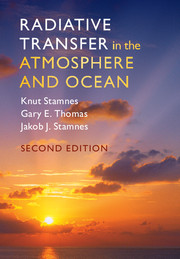Book contents
- Frontmatter
- Contents
- List of Illustrations
- List of Tables
- 1 Basic Properties of Radiation, Atmospheres, and Oceans
- 2 Basic State Variables and the Radiative Transfer Equation
- 3 Basic Scattering Processes
- 4 Absorption by Solid, Aqueous, and Gaseous Media
- 5 Principles of Radiative Transfer
- 6 Formulation of Radiative Transfer Problems
- 7 Approximate Solutions of Prototype Problems
- 8 The Role of Radiation in Climate
- 9 Accurate Numerical Solutions of Prototype Problems
- 10 Shortwave Radiative Transfer in the Atmosphere and Ocean
- Appendix A Nomenclature: Glossary of Symbols
- Appendix B Physical Constants
- Appendix C Ocean Optics Nomenclature
- Appendix D Reflectance and Transmittance at an Interface
- References
- Index
6 - Formulation of Radiative Transfer Problems
Published online by Cambridge University Press: 13 July 2017
- Frontmatter
- Contents
- List of Illustrations
- List of Tables
- 1 Basic Properties of Radiation, Atmospheres, and Oceans
- 2 Basic State Variables and the Radiative Transfer Equation
- 3 Basic Scattering Processes
- 4 Absorption by Solid, Aqueous, and Gaseous Media
- 5 Principles of Radiative Transfer
- 6 Formulation of Radiative Transfer Problems
- 7 Approximate Solutions of Prototype Problems
- 8 The Role of Radiation in Climate
- 9 Accurate Numerical Solutions of Prototype Problems
- 10 Shortwave Radiative Transfer in the Atmosphere and Ocean
- Appendix A Nomenclature: Glossary of Symbols
- Appendix B Physical Constants
- Appendix C Ocean Optics Nomenclature
- Appendix D Reflectance and Transmittance at an Interface
- References
- Index
Summary
Introduction
In this chapter, we further refine the mathematical description of the radiative transfer process. We will find that it is as important to be able to set up a problem correctly as it is to solve it. Experience has shown that an investment of attention at the “front-end” is well rewarded when it comes time to submit the problem to analytic or numerical solutions. To quote Einstein and Infeld (1966, page 92):
The formulation of a problem is often more essential than its solution, which may be merely a matter of mathematical or experimental skill.
For example, some applications aremore amenable to an integral-equation approach. In other cases, a transformation can convert a problem which might involve hundreds of terms in the expansion of the scattering phase function, to one involving just a few terms. Also, in scattering problems it is usually advisable to separate the direct solar component from the diffuse component. Finally, we will introduce several prototype problems, which are invaluable as tools for learning various solution techniques. Since accurate solutions to these problems are readily available, they provide a practical means of testing numerical techniques which can then be applied to more realistic problems.
Separation into Diffuse and Direct (Solar) Components
There are two distinctly different components of the shortwave radiation field. The first one is the direct or solar component Iνs, which is that part of the solar radiation field which has survived extinction, that is,
This part is sometimes called the “uncollided” component. The second part of the radiation is the diffuse component Iνd, which consists of light that has been scattered at least once. This part is also called the multiple-scattering component, which may be thought of as the medium's “self-illumination.” A particular volume element of the medium can be said to be illuminated by two sources: by the Sun and by the rest of the medium (including the planetary surface or the bottom of the ocean).
- Type
- Chapter
- Information
- Radiative Transfer in the Atmosphere and Ocean , pp. 186 - 226Publisher: Cambridge University PressPrint publication year: 2017
- 1
- Cited by



